|
Warm nights with temperatures slightly below 20° C, absence of real darkness due to Sun passing
close north horizon at midnight and light pollution from the nearby
city Zlin—typical night of the end of June
2006 does not favor deep sky imaging. But digital image processing can
easily subtract sky background and cooled astronomical camera can
easily keep the CCD chip at -15° C to
almost eliminate noise.
NGC 7048
The small planetary nebula NGC 7048 in Cygnus angular size
is only 1' × 0.8'.
It is about 1600 pc (approx.
5200 l.y.) apart. It is quite
difficult to capture it as it appears so small and quite dim.
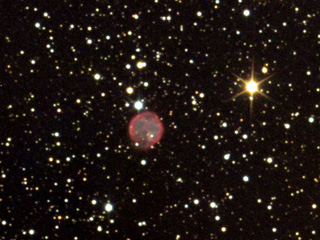
NGC 7048 planetary nebula in Cygnus
| Date |
June 13th, 2006 |
| Filter |
Exposure |
Binning |
| Luminance (IR-block) |
14.5 min |
1 × 1 |
| Red |
14.5 min |
1 × 1 |
| Green |
19 min |
1 × 1 |
| Blue |
20.5 min |
1 × 1 |
This is the first deep-sky image captured by G2CCD-1600
prototype camera. Image by V. Pribik.
M13 Hercules Cluster
Famous globular cluster M13 in Hercules is probably the best
known globular cluster on the northern hemisphere. It is bright
and big and easy to image. We pointed our telescope to it only to
check the mount setup and camera focus. But we cannot resist to
spend a few minutes imaging of this beautiful object before we
move the telescope to the XO-1 star in Corona Borealis for the
newly discovered exoplanet transit observation. The resulting
image is far from perfect, but we consider it is aesthetically
satisfying so we publish it here.
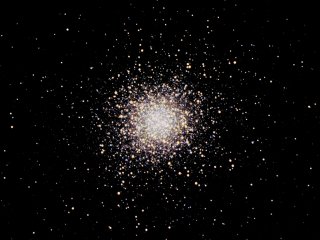
M13 globular cluster in Hercules
| Date |
June 20th, 2006 |
| Filter |
Exposure |
Binning |
| Luminance (IR-block) |
2 min |
1 × 1 |
| Red |
2 min |
1 × 1 |
| Green |
2 min |
1 × 1 |
| Blue |
2.5 min |
1 × 1 |
M27 Dumbbell Nebula
Dumbbell is a nice target for telescopes of all sizes. Although
even small telescope shows two bright spots, its shape is much
more similar to apple core than to dumbbell. Good image shows rich
details in the nebulosity. M27 angular size is 8' × 6' and it is 380 pc (approx. 1,250 l.y.) apart.
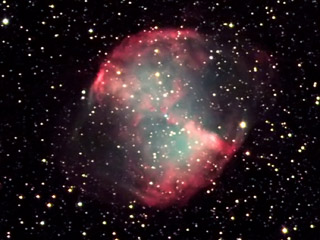
M27 Dumbbell Nebula in Vulpecula
| Date |
July 4th, 2006 |
| Filter |
Exposure |
Binning |
| Clear |
17 min |
1 × 1 |
| Red |
15 min |
1 × 1 |
| Green |
20 min |
1 × 1 |
| Blue |
21 min |
1 × 1 |
M57 Ring Nebula
M57 Ring Nebula is bright but angularly small. It can be easily
mistaken for ordinary star at low magnifications. Successful
imaging requires long focal length and good seeing. But it is
bright enough to be easily captured using slow telescopes. M57 is
approx. 700 pc (2300 l.y.) apart.
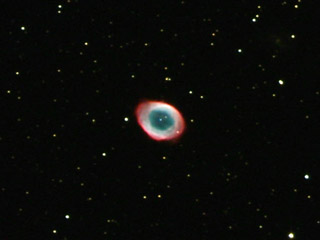
M57 Ring Nebula in Lyra
| Date |
July 4th, 2006 |
| Filter |
Exposure |
Binning |
| Clear |
4.5 min |
1 × 1 |
| Red |
8 min |
1 × 1 |
| Green |
7 min |
1 × 1 |
| Blue |
10 min |
1 × 1 |
NGC 6888 Crescent Nebula
Crescent nebula in Cygnus is relatively large, but considerably
dimmer then Dumbbell or Ring. Even the big CCD chip in G2CCD-1600
camera cannot show the whole nebula in one frame thanks to long
focal length of the used telescope. The bubble of interstellar gas
comprising the nebula has approx. 25 l.y. across and its distance is estimated to
5,000 l.y. The bubble
was created by the solar wind of the bright star close to the
nebula center.
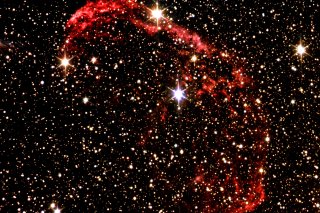
NGC 6888 Crescent Nebula in Cygnus
| Date |
July 25th, 2006 |
| Filter |
Exposure |
Binning |
| Clear |
30 min |
1 × 1 |
| Red |
20 min |
2 × 2 |
| Green |
7.5 min |
2 × 2 |
| Blue |
9.5 min |
2 × 2 |
We have imaged the nebula once again a few days later with
cheap, 8 inch f/4 Chinese reflector
to cover wider field of view. The image had to be cropped to
800 × 600 pixels, because image
borders was distorted by coma aberration. But fast f/4 mirror
cannot reach the image quality of the larger f/8 mirror—even star images at the center are fuzzier than
stars on the image above. Also the nebulosity is less distinct,
but this can be the result of shorter exposure.
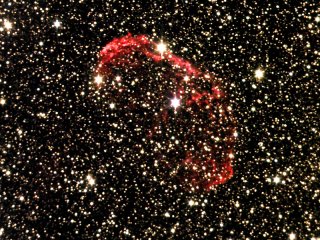
NGC 6888 Crescent Nebula imaged through cheap
8 inch f/4 reflector
| Date |
July 27th, 2006 |
| Filter |
Exposure |
Binning |
| Clear |
20.5 min |
1 × 1 |
| Red |
10.5 min |
1 × 1 |
| Green |
10 min |
1 × 1 |
| Blue |
10 min |
1 × 1 |
All images (if not explicitly stated) were captured by 27 cm f/8 Newtonian reflector of the Zlin city
observatory and G2CCD-1600 CCD camera.
Images by Pavel Cagas, Petr Cagas and Vaclav Pribik.
|